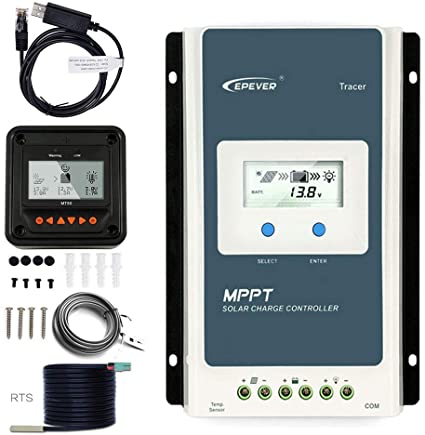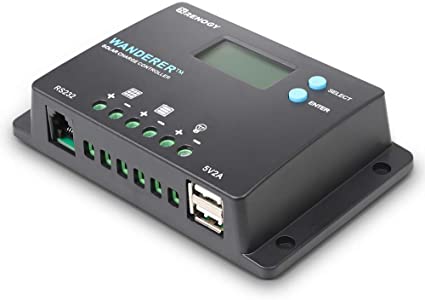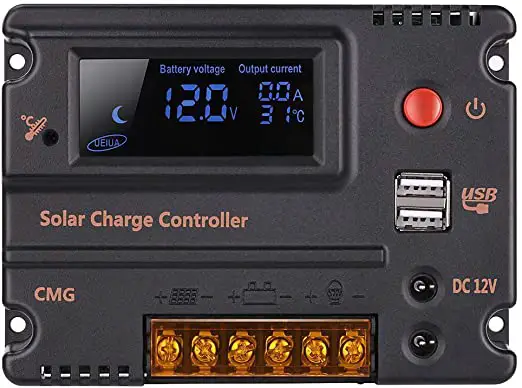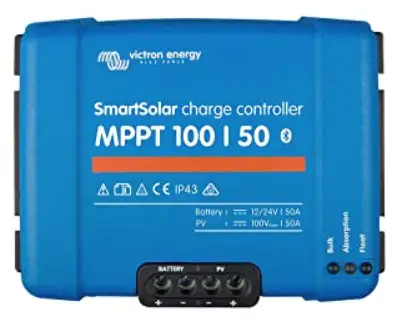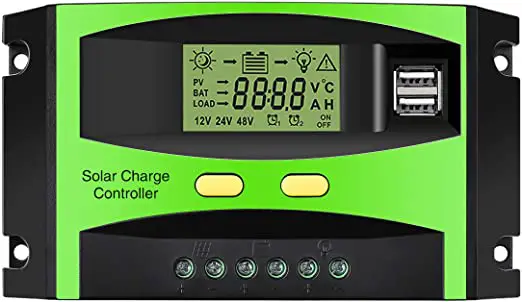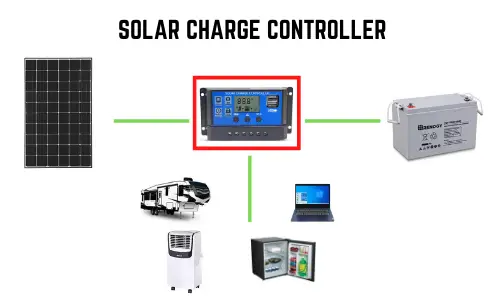
In this buyer's guide, let's check out these 6 best solar charge controllers on the market based on their performance, advanced features and cost.
There are many options, so we recommend sticking with products that are proven to work.
Let's check them out
EPEVER MPPT CHARGE CONTROLLER
Why did we pick this charge controller? With EPEVER's latest, MPPT technology, off-grid PV system expert, the tracking efficiency is beyond 99% efficient. By using a common-negative ground controller, the right model is able to control up to 520 Watts of electricity with a maximum solar input voltage of 100 volts. You can check it out here.
What are users saying about this charge controller?
Highly Efficient Charge Controller- The MPPT charge controller comes with a 12/24 volt DC mode that can be changed manually depending on the type of battery you’ve got. With an ultra-fast tracking speed and a tracking efficiency of more than 99%, this charge controller is going to be well worth the price.
Remote Meter Display- Displays automatically and identifies the controller, display type, model, real time energy statistics and the relevant parameter data to optimize power input.
Remote Temperature Sensor- Maintain the proper temperature of the battery without overheating or overcooling ( -131° F to 257° F) to prevent your battery from discharging in extreme temperatures.
Auto Update- Automatically update the firmware when available without the user's attention via the onboard Solar Station PC software
Why did we choose this solar charge controller? Optimized for 12V deep cycle batteries, gel batteries, flooded batteries, and lithium batteries without breaking the bank. You can ensure the safety of your battery and your solar system with Renogy’s solar charge controller. Check it out on Amazon’s website today.
What are users saying about this solar charge controller?
Bluetooth Connection- Check easy to read charge status on either the LCD screen on the controller itself or run diagnostics and system updates by using your phone and the Renogy BT smartphone app via The integrated RS232 port
Smart 4 Stage PWM Charging - Increases battery life and improves system performance for bulk, boost, float and equalization
Intel Protection - Protect against reverse polarity, overcharging, short circuit and reverse current
Newer Technology- Do the same thing other charge controllers can but at 1/10 the cost.
Why did we choose this solar charge controller? GHB’s solar charge controller can automatically manage the working of solar panels and batteries within your solar system. No matter at home or on the road in your RV, the GHB solar charge controller operates fully automatically to make sure that your battery can live its longest while outputting the most power and electricity that it can—environmental protection and energy-saving is a big deal! Check it out at Amazon here.
What are other users saying about this solar charge controller?
Dual USB Charging- Simultaneously charge or supply power to two mobile phones, tablets, PCs, and other devices that require 5 volts of power.
Fully Automatic- Maintain 100% of the most power as much as possible without using extra electricity to run the controller to minimize loss.
Provides Full Protection- Added protection against overloading, short-circuiting, lightning, under-voltage, overcharging, and reverse polarity.
Why did we choose this charge controller? SmartSolar maximizes this energy-harvesting process by driving the energy intelligently to achieve full charge in the shortest time possible up to 30% compared to PWM charge controllers & up to 10% compared to slower MPPT controllers.
What are other users saying about this product?
Advanced Technology- Recharge a severely depleted battery as low as zero volts to full charge fast while maintain its health and it will reconnect to a fully discharged battery with integrated disconnect function
Internal Tempearture Sensor - Compensates absorption and float charge voltage for temperature
Premium Monitoring- Use built-in bluetooth feature to monitor load output to prevent battery damage or excessive drain
Intel Battery Management - Monitor he state of charge and the load disconnect level will be modulated to achieve 100% recharge once a week
Why did we choose this solar charge controller? The MOHOO 30A solar controller can do everything other charge controllers we have recommended above. Check it out on Amazon’s website here.
What are other users saying about this solar charge controller?
Prevents Voltage Drops- Avoid voltage drops caused by excessively long wires which would affect the normal voltage judgement and cause the system to glitch out.
Built In Fail Safe - Automatically turn off, once the voltage of the battery drops below 8 volts to protect the battery
Advanced Features- Monitor the system status at any given time via a large LCD display. The intelligent PWM charging mode keeps constant battery voltage and maintain battery health
WHAT TO LOOK FOR IN A SOLAR CHARGE CONTROLLER
There were many things to consider when picking the best solar charge controllers to be put on our top 6 list. You may have seen terms and acronyms within the product description above that you might’ve not understood clearly—no worries! We’ll break it down for you.
Type: MPPT vs. PWM
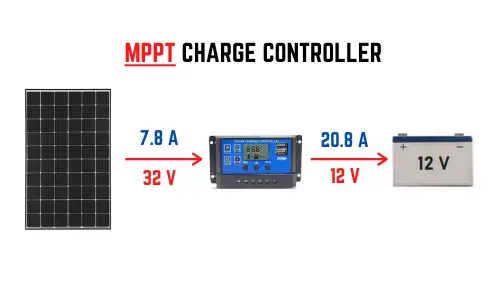
What is MPPT and why are you seeing it in most product descriptions? MPPT stands for Maximum Power Point Tracking, and it’s a technique that’s commonly used with solar panels, wind turbines, and photovoltaic solar systems to maximize the amount of power that’s being extracted under all conditions.
Not only is it great for saving your battery’s life, it’s also great for pinpointing the spots where you lose the most power.
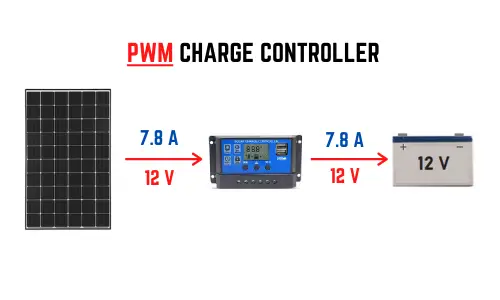
PWM, on the other hand, stands for Pulse Width Modulation. A PWM charge controller can be thought of as an electronic switch between solar panels and the battery—when the switch is on, that means the charger mode is in bulk charging mode which lets you get the most power in while sacrificing some battery life, for emergency and special cases.
Battery Voltage
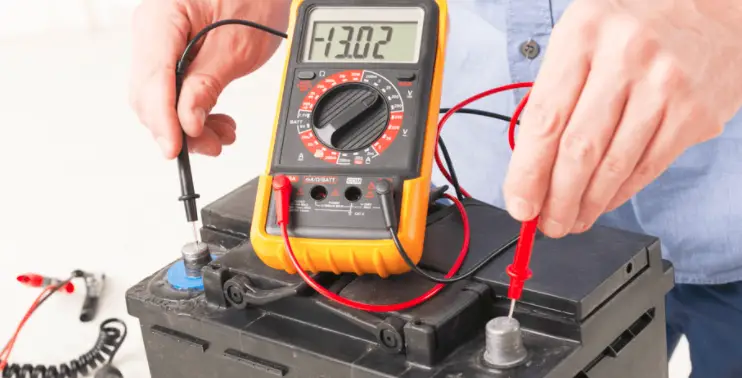
Battery voltage is how much of a “push” of electrical current there is. Imagine a water faucet: when the faucet is barely open, there’s not a lot of water coming out, but on the inside, the cap that stops the water is facing a lot of resistance because there’s an immense amount of push on the cap. When the faucet is completely open, the water bursts out because of that push.
With solar charge controllers, the power collected from solar panels has to go through the controller to make sure that it’s “allowed” into the battery without damaging the battery by overcharging. The voltage shown just lets you know how fast all of this electricity can be processed through the controller—the higher the voltage, the better.
Max Input Voltage
The max input voltage is basically the maximum usable DC power from the solar controller allowed to flow from the panel to the controller. The larger the value of the max input voltage is, the better, but the larger that value gets, the more expensive the controller gets as well.
Max Current Output
Since solar charge controllers aren’t measured by how big they are, they’re measured by the maximum current output. For PWM controllers, they’re unable to limit the current output, so they’re all rated the same, but for MPPT controllers, the higher that the value for the max current output is, the better that the solar charge controller is, just like the maximum input voltage.
Safety Features
One of the safety features on solar charge controllers is the overload protection. If the current that flows in to your batteries is much higher than what the circuit can deal with, your system overloads and damages a lot of components, but with overloading protection, you can stop your batteries from getting damaged which can save you a LOT of money in the long run.
Reverse current protection is also important.
During the daytime, the sunlight goes through the solar panels and goes in one direction towards the solar charge controller and then to the batteries.
During nighttime, panels may naturally pass some of that current in the reverse direction which causes discharge from the battery and the charge controller can prevent batter juice loss at night.
HOW DOES A CHARGE CONTROLLER WORK?
Ways to Connect to a Controller
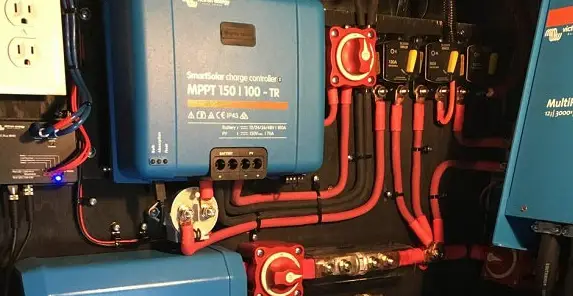
Usually the process is that a solar panel connects to a battery which is connected to an inverter, and usable power can be obtained from either the solar battery or the inverter depending on what kind of an inverter you’ve got, but if you’ve got a solar charge controller, the setup looks quite different.
The solar panel will now be connected directly with the charge controller, and the battery will also be directly connected to the charge controller. The inverter will still stay connected with the battery, but now, you’re able to charge small electronic devices through the charge controller as well if you’re wanting to leave the battery connection for bigger appliances.
Breakdown of Solar Charge Controller Ratings and Terminology
Solar charge controllers are rated and sized by the solar module array current and system voltage—the most common types are 12, 24, and 48-volt controllers. The amperage ratings normally run from 1 amp all the way up to 80 amps whereas the voltage goes from 6-600 volts, usually.
Usually, the bigger the number of voltage and amperage there is on the solar charge controller, the better it is for your system, but depending on what all is powered from the batteries, you won’t be needing the highest-powered system to charge the battery that powers up two iPhones and a laptop.
FACTORS TO CONSIDER BEFORE PURCHASING A CHARGE CONTROLLER
Specific Use
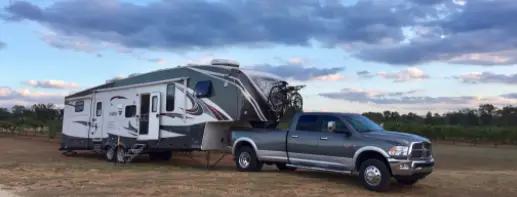
The specific usage of the solar charge controller can influence you to buy a different controller for different usages. There are different controllers needed to power up an RV versus powering up an entire house. The setups will look different along with the functionality.
The products listed above are perfect for a household usage and for off-grid use, but if you’ve got a partial-grid solar system, you’ll be needing a slightly different module. For partial-grid houses, since about half of the electricity comes from the solar panels and the other half comes from the city’s power grid, you’ll want to make sure that the charge controller isn’t interfering or connected to the house’s grid in any way.
Weather Exposure

Most solar charge controllers are meant to be indoors and shouldn’t be introduced to water in any way. For RVs, the solar panels are most likely weather-proof, but the connections and wiring that runs through the system is mostly kept indoors.
Some of the premium solar charge controllers listed above are lightning-proof. Lightning is a big deal for electronics—if lightning strikes a house and something within the house isn’t grounded, it can easily be damaged or destroyed, and the same goes for charge controllers. Most of the controllers will have lightning protection to protect against a bolt striking against your house or RV.
Wire Size
Study shows that the longer your wiring is, or the longer the distance between two wired components is, less and less power will be transported over that distance. The thinner that the wire gets, the more that the voltage within the wire drops—the same goes for how long the wire is.
For the thinnest type of wire with the distance of a foot already witnesses a voltage drop of 1.75%, but by going 10 times the distance to 10 feet, the voltage drops nearly 20% by the time it reaches its destination. This goes to show how important it is to have thicker wires with shorter distances between each component.
Read More: 12V and 24V Wire Sizing & Cost Breakdown
Solar Panel Size and Power Required
Having solar panels that are big isn't that big of a deal once it comes to solar charge controllers since it’s recommended to have a controller if you have one panel or a hundred.
But if you’re powering up a whole household with solar panels, you won’t be needing more than one solar charge controller, but you might be needing a really good controller—you’ll want to spend more money buying the solar charge controllers that provide the most voltage inputs and the most current outputs while providing the most protection.
Devices Being Powered Up
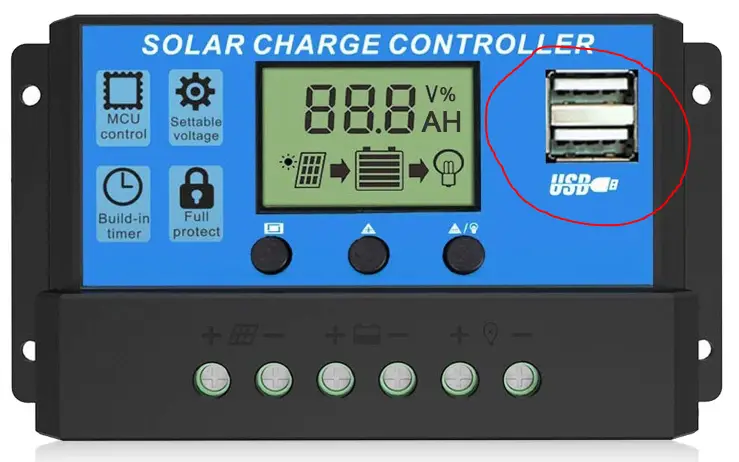
Having a helpful solar charge controller allows you to run some USB connections from the controller to your USB-powered devices.
Usually more applicable in RVs, some people like to save the battery life inside of banks to power bigger electronics like their televisions or air condition, but you can also hook up a phone charger to a charge controller if it allows you to. Although it isn’t recommended, if you’ve got a good charge controller, you can get away with plugging in your laptop with the controller without messing up your system.
Obviously, for bigger solar systems, you’ll want a solar charge controller that’ll allow you to get enough power through to power up bigger appliances. If you’re powering up a washer/dryer along with air conditioning and a dishwasher, you’ll definitely want to spend a little extra, ensuring that the power coming from the solar panels can go be directed from the controller to the battery without damaging the bank in any way.

